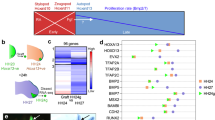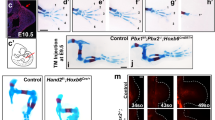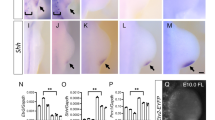Abstract
RETINOIC acid has profound effects on vertebrate limb morphogenesis (refs 1–6, reviewed in refs 7–9), including in the mouse, where it can act as a teratogen generating phocomelia and bone defects10–12. A retinoic acid gradient13–15, possibly amplified by a graded distribution of cellular retinoic acid-binding protein (CRABP) 16, could provide positional information across the antero-posterior axis of the chick limb bud. The discovery of nuclear retinoic acid receptors (RARs) 17–22 acting as retinoic acid-inducible enhancer factors (reviewed in refs 23,24) provided a basis for understanding how retinoic acid signals could be transduced at the level of gene expression25. We have now used in situ hybridization to study the distribution of messenger RNA transcripts of the three murine receptors (mRARs) and CRABP during mouse limb development. Both mRARoα and mRARγ transcripts, but not those for mRARβ, are present and uniformly distributed in the limb bud at day 10 post-coitum, whereas CRABP transcripts have a graded proximo-distal distribution, indicating that differential expression of CRABP, but not of mRARα or mRARγ, could participate in the establishment of the morphogenetic field. At later stages, mRARγ transcripts become specific to the cartilage cell lineage and to the differentiating skin and mRARβ transcripts are mostly restricted to the interdigital mesenchyme. CRABP transcripts, however, are excluded from regions expressing mRARγ; and mRARβ. These results indicate that all three RARs and CRABP have specific functions during morphogenesis and differentiation of the mouse limb.
This is a preview of subscription content, access via your institution
Access options
Subscribe to this journal
Receive 51 print issues and online access
$199.00 per year
only $3.90 per issue
Buy this article
- Purchase on Springer Link
- Instant access to full article PDF
Prices may be subject to local taxes which are calculated during checkout
Similar content being viewed by others
References
Maden, M. Nature 295, 672–675 (1982).
Thorns, S. D. & Stocum, D. L. Devl Biol. 103, 319–328 (1984).
Scadding, S. R. & Maden, M. J. embryol. exp. Morphol. 91, 35–53 (1986).
Tickle, C., Alberts, B. M., Wolpert, L. & Lee, J. Nature 296, 564–565 (1982).
Summerbell, D. J. Embryol. exp. Morphol. 78, 269–289 (1983).
Tickle, C., Lee, J. & Eichele, G. Devl Biol. 109, 82–95 (1985).
Maden, M. Trends Genet. 1, 103–107 (1985).
Brockes, J. P. Neuron 2, 1285–1294 (1989).
Eichele, G. Trends Genet. 5, 246–251 (1989).
Kochhar, D. M. Teratology 7, 289–299 (1973).
Satre, M. A. & Kochhar, D. M. Devl Biol. 133, 529–536 (1989).
Sulik, K. K., Johnston, M. C. & Dehart, D. B. Teratology 35, 32A (1987).
Thaller, C. & Eichele, G. Nature 327, 625–628 (1987).
Slack, J. M. W. Nature 327, 553–554 (1987).
Thaller, C. & Eichele, G. Development 103, 473–483 (1988).
Maden, M., Ong, D. E., Summberbell, D. & Chytil, F. Nature 335, 733–735 (1988).
Petkovich, M., Brand, N. J., Krust, A. & Chambon, P. Nature 330, 444–450 (1987).
Giguere, V., Ong, E. S., Segui, P. & Evans, R. M. Nature 330, 624–629 (1987).
Brand, N. et al. Nature 332, 850–853 (1988).
Benbrook, D., Lernhardt, E. & Pfahl, M. Nature 333, 669–672 (1988).
Zelent, A., Krust, A., Petkovich, M., Kastner, P. & Chambon, P. Nature 339, 714–717 (1989).
Krust, A., Kastner, P., Petkovich, M., Zelent, A. & Chambon, P. Proc. natn. Acad. Sci. U.S.A. 86, 5310–5314 (1989).
Green, S. & Chambon, P. Trends genet. 4, 309–314 (1988).
Evans, R. M. Science 240, 889–895 (1988).
Robertson, M. Nature 330, 420–421 (1987).
Stoner, C. M. & Gudas, L. J. Cancer Res. 49, 1497–1504 (1989).
Ruberte, E. et al. Development (in the press).
Gallandre, F. & Kistler, A. Wilhelm Roux Arch. dev. Biol. 189, 25–33 (1980).
Kochhar, D, M., Penner, J. D. & Tellone, C. Teratog. Carcinog. Mutagen. 4, 377–387 (1984).
Shapiro, S. S. in Retinoids and Cell Differentiation (ed. H. I. Sherman) 30–55 (1985).
Menkes, B. & Ilies, A. Revue rom. embryol. Cytol. 2, 161–172 (1965).
Kapan, R., Traska, G. & Fuchs, E. J. cell. biol. 105, 427–440 (1987).
Kapan, R. & Fuchs, E. J. cell. Biol. 109, 295–307 (1989).
Green, S., Issemann, I. & Scheer, E. Nucleic Acids Res. 16, 369–372 (1988).
Dollé, P. & Duboule, D. Embo J. 8, 1507–1515 (1989).
Author information
Authors and Affiliations
Rights and permissions
About this article
Cite this article
Dollé, P., Ruberte, E., Kastner, P. et al. Differential expression of genes encoding α, β and γ retinoic acid receptors and CRABP in the developing limbs of the mouse. Nature 342, 702–705 (1989). https://doi.org/10.1038/342702a0
Received:
Accepted:
Issue Date:
DOI: https://doi.org/10.1038/342702a0
This article is cited by
-
Caspase-8, receptor-interacting protein kinase 1 (RIPK1), and RIPK3 regulate retinoic acid-induced cell differentiation and necroptosis
Cell Death & Differentiation (2020)
-
Inhibitory effect of retinoic acid receptor agonists on in vitro chondrogenic differentiation
Anatomical Science International (2020)
-
Sculpturing digit shape by cell death
Apoptosis (2010)
-
Getting under the skin of epidermal morphogenesis
Nature Reviews Genetics (2002)
Comments
By submitting a comment you agree to abide by our Terms and Community Guidelines. If you find something abusive or that does not comply with our terms or guidelines please flag it as inappropriate.



